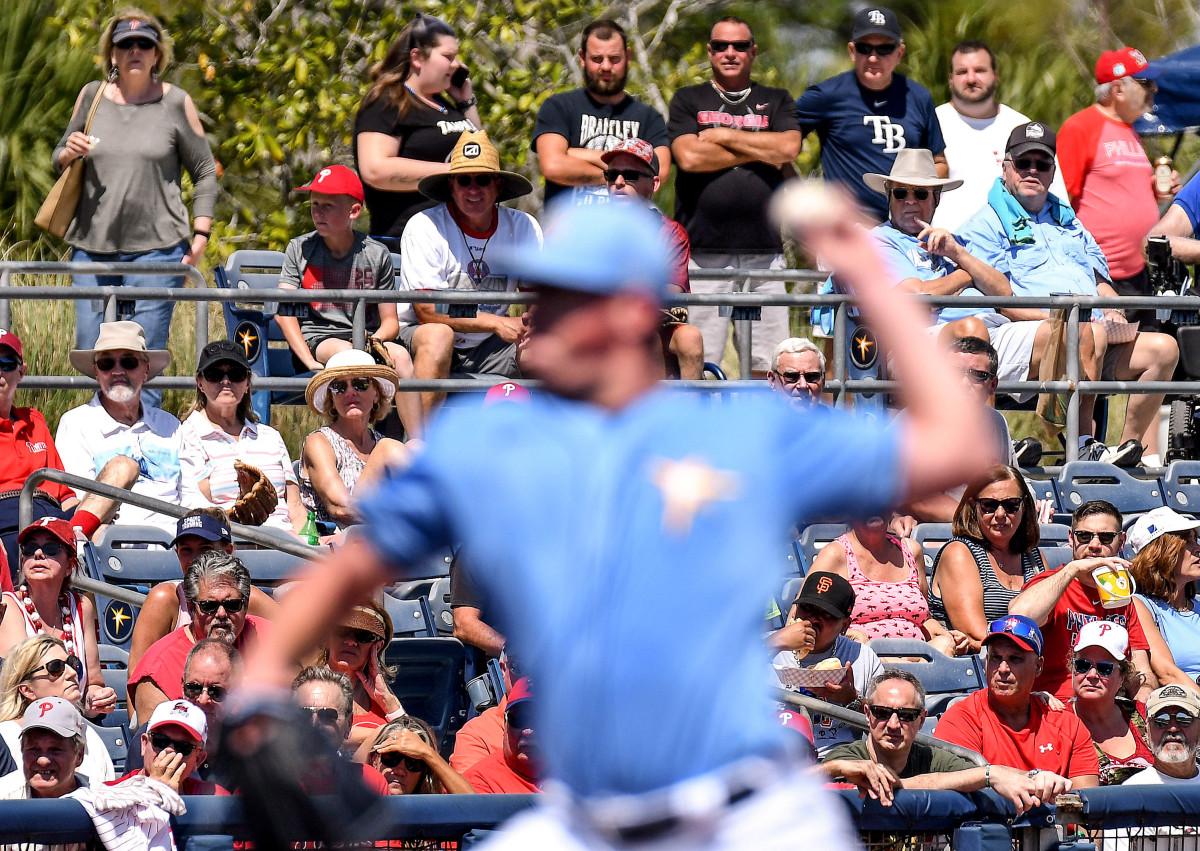The Last Ordinary Inning
MLB’s last at bat before the coronavirus was Ruben Cardenas’s first.
The outfielder—22 years old and in the low minors with the Rays—stepped into the box for his first career plate appearance in a major league spring game. With two outs in the bottom of the ninth, he’d been brought in as a pinch-hitter; many players get their first spring at bats this way, in the late innings of a game after the starters have been removed. But this was an ordinary setup under extraordinary circumstances. The game was the last ongoing event in major U.S. professional team sports, and if Cardenas got on base, he would keep sports alive for just a little bit longer.
It was almost 4 p.m. on March 12. The NBA had suspended its season the night before due to COVID-19. In the morning, statements came from almost every other major sport: MLS, the NHL, the ATP and WTA, various conference basketball tournaments across the NCAA, U.S. Soccer. Even out-of-season leagues made announcements. The NFL said it would cancel its annual league meeting, and the WNBA said it was considering alternate scenarios for its draft next month. But spring training games started on time. As the hours ticked by, news about the virus became bleaker, with growing reports of positive tests and community closures, and these games felt increasingly anachronistic—a relic of a world that seemed to be slipping away by the minute.
MLB finally made an announcement a little after 3 p.m. The league would postpone the regular season and suspend spring training indefinitely—after the six games that were already underway had finished. It was an odd situation even by what was then a quickly shifting definition of “odd”: NBA games had been called off the previous night just before tip-off, and a handful of NCAA games had been shut down that afternoon at halftime, but no other athletes had been allowed to keep playing after learning that it would be their last time doing so for the foreseeable future. This was a weird liminal space that belonged only to baseball.
These last six games finished one by one, until professional baseball consisted of only a slow-moving contest between the Phillies and the Rays, winding down to its last batter.
This was Cardenas—who’d tried to tune out dugout chatter about the league announcement as he concentrated on the chances for his first spring at bat. (He’d appeared in one game the previous spring as a defensive substitute but had not had an opportunity to hit.) He came to the plate with the immediate status of the sport resting on his shoulders. And he struck out looking.
“I was so frustrated that I struck out because that was my first real at bat,” he says. “I was so frustrated that honestly I wasn’t even thinking about anything else. And then once I got in the locker room and got on my phone—I was like, Oh, wow, I just struck out to end major league spring training.”

The final innings of spring games are clunky affairs by design. The score doesn’t matter; the box score, loaded with substitutions, is full of players that even the most dedicated fans might not recognize. It can feel like the very definition of meaningless baseball. (This year, under MLB’s protocol for COVID-19, these innings might not even exist: Managers can agree to shorten a spring game to five or seven innings in an acknowledgement that, really, those last few frames don’t do much for anyone.) To watch the end of those games on March 12, against a backdrop of increasingly grim news, was to wonder the same question with each passing minute: Why hasn’t this whole thing been shut down yet?
But for the players—minor leaguers, by and large, unsure of what would come next—these innings were their last chances to do their jobs.
There was no formal announcement in the stadium that spring training had been suspended. Phillies first baseman Rhys Hoskins said after the game that he had heard from a fan in the stadium; Rays manager Kevin Cash said that he found out from a staffer who happened to have his phone on him in the dugout. In the bullpen, Phillies reliever Jonathan Hennigan—who would come in for the ninth and throw the final pitch of spring training—learned the news around the sixth inning from a fan walking past the ’pen.
“Some guy was arguing back and forth with us about it,” Hennigan says. The relievers knew what had happened the night before in the NBA; they understood that it was likely only a matter of time before baseball would get the same message. But that the sport would be suspended then, in the middle of a game, and they’d hear it first from a fan? “We’re like, Man, there’s no way, they’re not just going to shut down baseball like that—impossible, you know?”
With no physical signifiers that anything had changed, the game looked identical to the one they'd played yesterday and the day before that. But it was hard to shake the weirdness that came with the knowledge they wouldn't be playing again tomorrow. There was nothing to do but keep going, until, eventually, they were the only ones left playing.
“We all started at one o’clock,” Rays radio broadcaster Neil Solondz says of the last six spring games. “But our game lasted so long that you’re realizing, Wow, we’re the last one, and we don’t know when we’re playing again. … By the end of the game, you didn’t even know what the next day was going to be like.”
Hennigan says that he barely remembers warming up for the ninth. (For him, like Cardenas, the day felt like a milestone: It was just his second career appearance in a spring game and his first time starting a fresh inning.) He walked to the mound thinking about a line that he’d been told since he was a kid—pitch each game as if it’s your last—and wondering whether it might apply in a different sense here.

Read More Stories On the Year of the Shutdown
His leadoff hitter was infield prospect Xavier Edwards. The 20-year-old had entered the game in the sixth inning—shortly after rumors about the suspension started flying around the dugout, meaning that he had a sense of the moment when he stepped on the field, wondering when he’d get to do it again. “It was kind of like the end of a season, you know, last game, this is it, we’re going to go home for a while,” he says. “It was like that, but not knowing how long we’d be gone for.”
Edwards swung at the first pitch he saw and made contact for an infield single—a move that made it briefly seem as if, maybe, this game would keep on going, and baseball would last a bit longer. But it wrapped up quickly from there. Outfielder Randy Arozarena grounded into a fielder’s choice. Catcher Michael Pérez flew out to right. And then it was down to Cardenas.
“That’s your ballgame,” Solondz declared on the broadcast as the outfielder struck out on a pitch on the outside corner. “And we don’t know how long it’ll be our final ballgame.”
The players shook hands for the last time. And Solondz signed off: “We went from telling a story,” he says now, a year later, “to just following along like everybody else.”
Afterward, in the locker room, players learned officially what they had been hearing around the field for the last hour. But there was no sense yet of what it actually meant. They didn’t know whether they’d be able to stay in town to work out, or whether they’d have to go home immediately, or whether they’d be called back at their spring complexes in weeks or months or not at all. Edwards remembers teammates leaving gear in their lockers with the belief that they’d return in two weeks. He suspected otherwise—“I was like, I’m just going to be on the safe side, and I’m going to bring everything with me.”
Hennigan held on to the baseball that he’d used to strike out Cardenas. He didn’t know what he’d do with it—if it had been worth grabbing at all, if this would be a brief hiatus or a historic break, if his last pitch of spring training would eventually mean something to anyone other than him.
Soon, the team closed its complex in Florida, and he was sent home to Texas, where he set the ball on his mantel. It’s still there—a reminder of baseball’s last ordinary inning.
